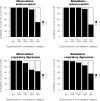Pharmacokinetic-pharmacodynamic modeling of the effectiveness and safety of buprenorphine and fentanyl in rats
- PMID: 17914664
- PMCID: PMC2190336
- DOI: 10.1007/s11095-007-9440-z
Pharmacokinetic-pharmacodynamic modeling of the effectiveness and safety of buprenorphine and fentanyl in rats
Abstract
Objective: Respiratory depression is a serious and potentially life-threatening side-effect of opioid therapy. The objective of this investigation was to characterize the relationship between buprenorphine or fentanyl exposure and the effectiveness and safety outcome in rats.
Methods: Data on the time course of the antinociceptive and respiratory depressant effect were analyzed on the basis of population logistic regression PK-PD models using non-linear mixed effects modeling software (NONMEM). The pharmacokinetics of buprenorphine and fentanyl were described by a three- and two-compartment model, respectively. A logistic regression model (linear logit model) was used to characterize the relationship between drug exposure and the binary effectiveness and safety outcome.
Results: For buprenorphine, the odds ratios (OR) were 28.5 (95% CI, 6.9-50.1) and 2.10 (95% CI, 0.71-3.49) for the antinociceptive and respiratory depressant effect, respectively. For fentanyl these odds ratios were 3.03 (95% CI, 1.87-4.21) and 2.54 (95% CI, 1.26-3.82), respectively.
Conclusion: The calculated safety index (OR(antinociception)/OR(respiratory depression)) for fentanyl of 1.20 suggests that fentanyl has a low safety margin, implicating that fentanyl needs to be titrated with caution. For buprenorphine the safety index is 13.54 suggesting that buprenorphine is a relatively safe opioid.
Figures





Similar articles
-
Mechanism-based PK/PD modeling of the respiratory depressant effect of buprenorphine and fentanyl in healthy volunteers.Clin Pharmacol Ther. 2007 Jan;81(1):50-8. doi: 10.1038/sj.clpt.6100025. Clin Pharmacol Ther. 2007. PMID: 17185999 Clinical Trial.
-
Pharmacokinetic-pharmacodynamic modeling of the antinociceptive effect of buprenorphine and fentanyl in rats: role of receptor equilibration kinetics.J Pharmacol Exp Ther. 2005 Jun;313(3):1136-49. doi: 10.1124/jpet.104.082560. Epub 2005 Feb 8. J Pharmacol Exp Ther. 2005. PMID: 15701707
-
Mechanism-based pharmacokinetic-pharmacodynamic modeling of the respiratory-depressant effect of buprenorphine and fentanyl in rats.J Pharmacol Exp Ther. 2006 Nov;319(2):682-92. doi: 10.1124/jpet.106.107953. Epub 2006 Jul 19. J Pharmacol Exp Ther. 2006. PMID: 16855177
-
Opioids and the management of chronic severe pain in the elderly: consensus statement of an International Expert Panel with focus on the six clinically most often used World Health Organization Step III opioids (buprenorphine, fentanyl, hydromorphone, methadone, morphine, oxycodone).Pain Pract. 2008 Jul-Aug;8(4):287-313. doi: 10.1111/j.1533-2500.2008.00204.x. Epub 2008 May 23. Pain Pract. 2008. PMID: 18503626
-
Partial versus full agonists for opioid-mediated analgesia--focus on fentanyl and buprenorphine.Acta Anaesthesiol Belg. 2002;53(3):193-201. Acta Anaesthesiol Belg. 2002. PMID: 12461829 Review.
Cited by
-
Translational PK-PD modeling in pain.J Pharmacokinet Pharmacodyn. 2013 Jun;40(3):401-18. doi: 10.1007/s10928-012-9282-0. Epub 2012 Nov 30. J Pharmacokinet Pharmacodyn. 2013. PMID: 23197248 Review.
-
Antinociceptive effects of sustained-release buprenorphine in a model of incisional pain in rats (Rattus norvegicus).J Am Assoc Lab Anim Sci. 2014 Mar;53(2):193-7. J Am Assoc Lab Anim Sci. 2014. PMID: 24602547 Free PMC article.
-
Collateral Damage: Neurological Correlates of Non-Fatal Overdose in the Era of Fentanyl-Xylazine.Neurosci Insights. 2024 Apr 24;19:26331055241247156. doi: 10.1177/26331055241247156. eCollection 2024. Neurosci Insights. 2024. PMID: 39296815 Free PMC article.
-
Pharmacodynamic analysis of the analgesic effect of capsaicin 8% patch (Qutenza™) in diabetic neuropathic pain patients: detection of distinct response groups.J Pain Res. 2012;5:51-9. doi: 10.2147/JPR.S30406. Epub 2012 Mar 15. J Pain Res. 2012. PMID: 22536092 Free PMC article.
-
Previously published drug interaction models predict loss of response for transoesophageal echocardiography sedation well but not response to oesophageal instrumentation.Sci Rep. 2019 Mar 7;9(1):3806. doi: 10.1038/s41598-019-40366-3. Sci Rep. 2019. PMID: 30846741 Free PMC article.
References
-
- {'text': '', 'ref_index': 1, 'ids': [{'type': 'DOI', 'value': '10.2165/00002018-199819030-00002', 'is_inner': False, 'url': 'https://doi.org/10.2165/00002018-199819030-00002'}, {'type': 'PubMed', 'value': '9747665', 'is_inner': True, 'url': 'https://pubmed.ncbi.nlm.nih.gov/9747665/'}]}
- T. A. Bowdle. Adverse effects of opioid agonists and agonist–antagonists in anaesthesia. Drug Safety19:173–189 (1998). - PubMed
-
- {'text': '', 'ref_index': 1, 'ids': [{'type': 'DOI', 'value': '10.1213/01.ANE.0000219597.16143.4D', 'is_inner': False, 'url': 'https://doi.org/10.1213/01.ane.0000219597.16143.4d'}, {'type': 'PubMed', 'value': '16717343', 'is_inner': True, 'url': 'https://pubmed.ncbi.nlm.nih.gov/16717343/'}]}
- T. J. Gan. Risk factors for postoperative nausea and vomiting. Anesth. Analg.102:1884–1898 (2006). - PubMed
-
- {'text': '', 'ref_index': 1, 'ids': [{'type': 'DOI', 'value': '10.1056/NEJM200010263431705', 'is_inner': False, 'url': 'https://doi.org/10.1056/nejm200010263431705'}, {'type': 'PubMed', 'value': '11071674', 'is_inner': True, 'url': 'https://pubmed.ncbi.nlm.nih.gov/11071674/'}]}
- P. L. Bailey, J. K. Lu, N. L. Pace, J. A. Orr, J. L. White, E. A. Hamber, M. H. Slawson, D. J. Crouch, and D. E. Rollins. Effects of intrathecal morphine on the ventilatory response to hypoxia. N. Engl. J Med.343:1228–1234 (2000). - PubMed
-
- {'text': '', 'ref_index': 1, 'ids': [{'type': 'PubMed', 'value': '7907532', 'is_inner': True, 'url': 'https://pubmed.ncbi.nlm.nih.gov/7907532/'}]}
- A. D. Baxter. Respiratory depression with patient-controlled analgesia. Can. J. Anaesth.41:87–90 (1994). - PubMed
-
- {'text': '', 'ref_index': 1, 'ids': [{'type': 'PubMed', 'value': '8829938', 'is_inner': True, 'url': 'https://pubmed.ncbi.nlm.nih.gov/8829938/'}]}
- C. Lejus, Y. Blanloeil, T. Francois, S. Testa, P. Michel, and B. Dixneuf. Post-operative intravenous continuous analgesia: comparison of buprenorphine, fentanyl and nalbuphine. Eur. J. Anaesthesiol.13:57–65 (1996). - PubMed
MeSH terms
Substances
LinkOut - more resources
Full Text Sources

